mobile View, to the German Version tap the flag

To understand what was going on in Russia and the later Soviet Union, one should first define the used terms. The Russian Empire of the Tsar (until March 1917) and the short-lived bourgeois Russia (March 1917 to November 1917) were one and the same state. There was at first the Russian heartland, Russia as it existed until the middle of the 18th century, but excluding Finland, excluding Estonia and excluding Latvia. The non-Russian peoples who lived in this Old Russia were small nations in the Ural and Siberia area who had nothing to oppose the Russians in terms of the stage of development or the number of peoples and were quickly subjugated and integrated, sometimes even getting into the position of a minority. The Russian state then expanded to its greatest extent at the end of the 19th century. The following were annexed in the west (by the dissolution of Poland): the north of today's Ukraine, Belarus, Lithuania, Courland; in the south: the Caucasus region and the Turkestan states of Central Asia as well as in the Far East an area on the Amur River and the north of the Sakhalin Island. The Russian conquest in the Caucasus and in Central Alsia was different, more protracted and bloody, and the areas were threatened by frequent rebellions and uprisings.
The tsarist empire collapsed under the blows of the First World War, and due to an unstable internal situation and because of separatist movements in some nations, peoples and regions that took advantage of Russia's weakness and made themselves independent (e.g. Finland, Poland, Ukraine, Belarus, Latvia, Estonia, Lithuania). The bourgeois government could not stop this process, and it was clear to Lenin and the Bolshevik putschists that action had to be taken quickly if the grand goals were to be achieved. After the Lenin putsch, the country sank into a long civil war with the participation of separatist nations, Bolsheviks, bourgeois forces and supporters of the monarchy. In the area of Old Russia the Bolsheviks quickly asserted themselves, except for a few areas in the Far East.
The non-Russian peoples, living in Old Russia, hoped for an improvement in their situation compared to the Russians, possibly in towards autonomy and sometimes independence. The Bolsheviks had no interest in it, because in a Soviet system the nation plays no role in the ideology. In reality, however, a russification policy was being pursued, because the mass of uprooted, hungry and completely frightened people in the former Russian Empire, strived for as homogeneous, could be watched and controlled much better. The non-Russian peoples in Old Russia were quickly granted autonomy within quickly created republics. Then the Bolsheviks waited until an intellectual and economic leadership class had developed in a democratic process, in order to then eliminate it. The next steps were often the abolition of own writing systems in favor of the Cyrillic script, the spread of the Russian language as the second language, and later even as the first language. That corresponding processes is to be seen very clearly on the flags of these republics over the years. Initially there were single-colored red flags with a golden inscription in the respective national language, which were later supplemented by a Russian inscription and then the symbols of Soviet power in the form of hammer, sickle and star were often added, but not in every case. Later the inscriptions changed to simple initials, then written in Cyrillic, later also supplemented with initials of the name in Russian.
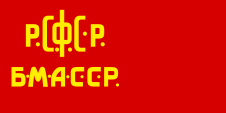
1923–1937,
Flag of the Buryatian Autonomous Soviet Republic
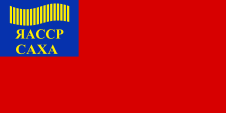
1926–1937,
Flag of the Yakutian Autonomous Soviet Republic
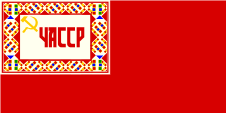
1927–1931,
Flag of the Chuvashia Autonomous Soviet Republic
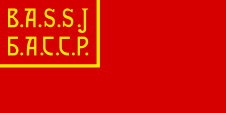
1919–1924,
Flag of the Bashkirian Autonomous Soviet Republic
In the west, in the Caucasus and also in Central Asia, the Bolshevik conquest proceeded differently. The Bolshevik Red Army was militarily too weak to actively oppose the nationalist secession at the external borders of the Russian Empire. The opponents of the Bolsheviks were often numerically strong and supported directly and indirectly from abroad. The Bolsheviks pursued the strategy of avoiding a direct confrontation and had Soviet republics proclaimed in these areas by Bolshevik allies, to which one after the other they could "come to the aid". This was not always successful, so Finland, Latvia, Estonia and Lithuania were able to defend their independence.
Belarus and Ukraine became the first victims of the Bolsheviks, the bourgeois forces of these countries were liquidated, the countries themselves formed into the first Soviet republics that were not re-annexed to Russia. In this way it was hoped to keep the nationalist camp at bay and to pacify it through a sham independence. Of course, the usual deportations, resettlements and the targeted massive influx of ethnic Russians followed the consolidation of Soviet power everywhere.
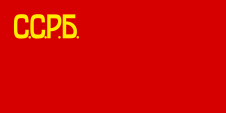
1920–1927,
Flag of the Byelorussian Socialist Soviet Republic
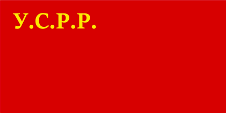
1919–1937,
Flag of the Ukrainian Socialist Soviet Republic
In the Caucasus and Central Asia, the Soviets proceeded more subtle. The Soviet republics – proclaimed by Bolshevik allies – acted less aggressively, gave Islam freedom and did nothing against nationalism, on the contrary. This could be seen very well on the flags of these Soviet republics. Some of that flags arose from the flags of the bourgeois governments, only the color red was brought into play somewhere over a large area by replacing another color, or the previous flag was taken over into the upper corner of a red flag. These flags then also showed national symbolism, but also crescent and star as symbols of Islam. Here hammer, sickle and star appeared relatively quickly on the flags, often in combination with the star of Islamic symbolism, at the same time as the imprisonment and liquidation of the remaining traditional elites. Later, all the bright colors were dropped from the flags, only red remained for the cloth and gold for the inscriptions. After the suppression of national and religious symbolism, the principle of inscriptions and initials was then adopted, first in the national language and script, later with Cyrillic additions and even later with Russian inscriptions.
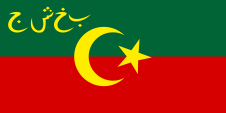
1920–1921,
Flag of the Socialistic People’s Republic of Buchara
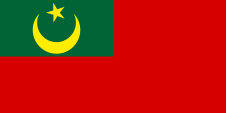
April bis Juli 1922,
Flag of the Khorazmian People's Soviet Republic
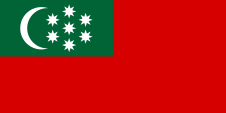
1921–1924,
Flag of the Mountain Autonomous Soviet Socialist Republic
In the Far East, the against the Soviets directed resistance struggle of the last remaining bourgeois forces and Japanese intervention troops became diverted, in this way that the Bolsheviks simply founded a "Far Eastern Republic" (1920 to 1922) and let this republic fight the fighting. Its flag was single-coloured red, only the blue upper corner showed the initials of the republic in red. Soviet Russia avoided in this way the direct conflict with Japan or even the USA via the "Far Eastern Republic" and it was able to play as a peace power. With the final establishment of Soviet power, the "Far Eastern Republic" was abolished.
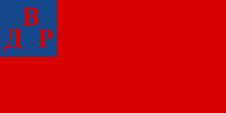
1920–1922,
Flag of the Far Eastern Republic
In 1922 the Soviet Union was founded, the amalgamation of Soviet Russia with the other, newly formed Soviet republics. Measured against the territory the Russian Empire was thus restored, albeit under the rule of the Bolsheviks, later called communists. Between 1949 and 1954, the flags of the Soviet Republics of the Soviet Union were completely redesigned, often with the help of local artists. In the end, each Soviet republic received its own, individually designed flag, but without foregoing on the one hand the color red as the dominant color and on the other hand the symbols of hammer, sickle and star. In addition to the Autonomous Soviet Republics established within Soviet Russia (Soviet Republic of Russia), more of these structures emerged within the other Soviet republics of the Soviet Union, which was founded in 1922. All of these Autonomous Soviet Republics received flags that were based on the flag of the respective superior Soviet republic, but were supplemented with the name of the country or the initials of the respective Autonomous Soviet Republic below hammer, sickle and star. This was often done in several languages, in several lines one below the other, in the script of the respective Latin, Cyrillic or an other alphabet.
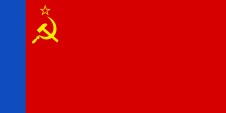
1954–1991,
Flag of the Russian Federative Socialist Soviet Republic
↓
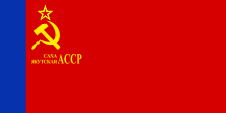
1954–1978,
Flag of the Yakut Soviet Autonomous Republic
__________
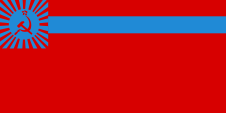
1951–1991,
Flag of the Georgian Socialist Soviet Republic
↓
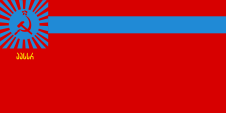
1981–1991,
Flag of the Ajarian Autonomous Socialist Soviet Republic


![]()













